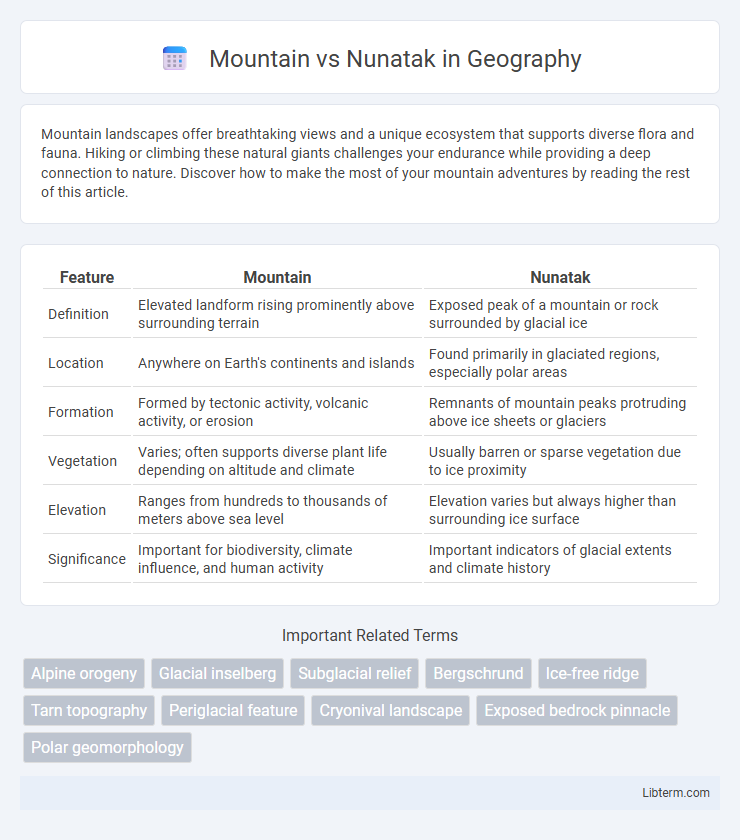Mountain landscapes offer breathtaking views and a unique ecosystem that supports diverse flora and fauna. Hiking or climbing these natural giants challenges your endurance while providing a deep connection to nature. Discover how to make the most of your mountain adventures by reading the rest of this article.
Table of Comparison
| Feature | Mountain | Nunatak |
|---|---|---|
| Definition | Elevated landform rising prominently above surrounding terrain | Exposed peak of a mountain or rock surrounded by glacial ice |
| Location | Anywhere on Earth's continents and islands | Found primarily in glaciated regions, especially polar areas |
| Formation | Formed by tectonic activity, volcanic activity, or erosion | Remnants of mountain peaks protruding above ice sheets or glaciers |
| Vegetation | Varies; often supports diverse plant life depending on altitude and climate | Usually barren or sparse vegetation due to ice proximity |
| Elevation | Ranges from hundreds to thousands of meters above sea level | Elevation varies but always higher than surrounding ice surface |
| Significance | Important for biodiversity, climate influence, and human activity | Important indicators of glacial extents and climate history |
Introduction to Mountains and Nunataks
Mountains are large landforms that rise prominently above their surroundings, typically formed through tectonic activity, volcanic processes, or erosion, and often characterized by steep slopes and significant elevation differences compared to nearby terrain. Nunataks are isolated peaks of rock that protrude above ice sheets or glaciers, serving as visible landmarks in polar and glacial regions where most land is covered by ice. While mountains can span a range of environments and ecosystems, nunataks provide critical habitat refuges and geological insights within frozen landscapes where ice dominates.
Defining Mountains: Key Characteristics
Mountains are prominent landforms characterized by significant elevation, steep slopes, and well-defined peaks, typically formed through tectonic forces, volcanic activity, or erosion. They influence climate patterns and support diverse ecosystems due to their altitude gradients and varied microclimates. Unlike nunataks, which are exposed rocky elements poking through glacial ice, mountains usually rise prominently above surrounding terrain without being encased in ice.
What is a Nunatak?
A nunatak is a rocky peak or ridge that protrudes above surrounding glaciers or ice fields, remaining exposed while ice covers the surrounding terrain. Unlike mountains fully surrounded by exposed land, nunataks are isolated by ice, providing critical habitats for unique plant and animal species. These geological formations serve as important natural markers in glaciated regions and offer insights into climate change and glacial history.
Geological Formation: Mountains vs Nunataks
Mountains form through tectonic plate collisions, volcanic activity, and erosion, creating large elevated landforms with continuous slopes and diverse rock types. Nunataks are isolated peaks that protrude above ice sheets or glaciers, typically formed from resistant bedrock that withstands glacial erosion. These geological formations highlight contrasting processes: mountains develop through long-term crustal deformation, while nunataks reveal landscapes shaped by persistent glacial coverage.
Climatic Influence on Mountains and Nunataks
Mountains significantly influence local climatic patterns by disrupting atmospheric circulation, causing orographic precipitation and creating rain shadows, while nunataks, isolated peaks protruding through ice sheets, experience extreme microclimates with limited vegetation due to their exposure and elevation. The persistent cold and wind conditions on nunataks result in reduced snow accumulation compared to surrounding glaciated areas, affecting local albedo and ice dynamics. Both landforms play critical roles in shaping regional weather patterns and ecosystems within their unique climatic contexts.
Biodiversity Differences
Mountains support diverse ecosystems with layered vegetation zones that vary by altitude, fostering high biodiversity including endemic species and complex animal habitats. Nunataks, isolated peaks surrounded by ice, exhibit limited biodiversity due to harsh climatic conditions and restricted soil development, often hosting specialized, cold-adapted flora and resilient microbes. The distinct environmental pressures result in mountains promoting richer biological communities compared to the sparse, specialized biota found on nunataks.
Ecological Roles in Their Environments
Mountains serve as extensive habitats that support diverse ecosystems, influencing local climate patterns and water cycles essential for flora and fauna. Nunataks, isolated rocky outcrops surrounded by ice, provide critical refuges for specialized, cold-adapted species and act as biodiversity hotspots in polar and glacial environments. Both formations contribute uniquely to ecological resilience by offering shelter and promoting species survival amid changing climates.
Human Exploration and Scientific Significance
Mountains serve as critical sites for human exploration due to their accessibility and diverse ecosystems, enabling extensive geological and ecological studies. Nunataks, isolated peaks protruding through ice sheets, provide unique scientific insights into glacial history, climate change, and isolated species survival. Both features contribute significantly to understanding Earth's geological processes and ecosystems in extreme environments.
Case Studies: Famous Mountains and Nunataks
Mount Everest stands as the highest mountain on Earth, showcasing classic alpine features and attracting climbers worldwide, while Mount Denali in Alaska exemplifies the grandeur of North American peaks. Nunataks, such as the Wilkins Nunatak in Antarctica, serve as critical refuges for unique flora and fauna, isolated amidst vast ice sheets, with research highlighting their importance in studying climate change and glacial history. Comparative case studies of mountains and nunataks reveal distinct geological formations and ecological niches shaped by varying environmental conditions and glaciation processes.
Conclusion: Comparing Mountains and Nunataks
Mountains are large landforms that rise prominently above their surroundings, often covered with vegetation and formed through tectonic activity. Nunataks are isolated peaks that protrude through ice sheets or glaciers, typically found in polar regions and serving as vital ecological refuges. The main distinction lies in their environment and formation, with mountains dominating terrestrial landscapes and nunataks existing within ice-covered terrains.
Mountain Infographic

 libterm.com
libterm.com